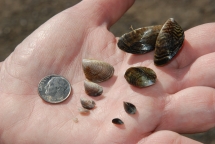Origin
The Quagga mussel is a bivalve mollusk, native to Ukraine. The mussels were established in the Great Lakes by 1989 and were first found west of the Continental Divide in 2007.
Introduction
Now, all water sourced from the Colorado River, including reservoirs, lakes and watersheds, have been exposed to Quagga mussels, with the first observation in the Colorado River being in January 2007. The mussels and the microscopic larvae can spread relatively easily due to being able to survive out of water for over a week – making on land transport of boats and watercraft a primary concern. Check the California Department of Fish and Wildlife Fact Sheetfor more information.
Ecological Effects
These mussels are highly invasive and have several biological traits that cause them to be detrimental to both environmental and economic systems. They have been found at densities of approximately 7,700 mussels per square meter. Up to one million eggs can be released each spawning cycle and the mussels can colonize from the surface of water to over 400 feet below the surface due to tolerance for low temperatures. They can live in habitats up to a salinity level of 6 parts per thousand, making estuaries possible sites for invasion to occur. The mussels are filter feeders, filtering large volumes of water daily. While the high amount of filtered water results in increased water clarity, this is not beneficial for existing ecosystems. They destroy ecosystems by reducing phytoplankton and zooplankton effectively stripping water systems of nutrients and disrupting food webs. The filtering of the upper water in lakes can result in increased productivity on lake bottoms. The waste and toxic byproducts of these mussels lower oxygen levels in the water, resulting in biofouling and increased presence of algae, as well as a lower pH and acidic conditions. Bioaccumulation of mercury, selenium, PCBs and PAHs occurs in the tissues of these mussels, resulting in botulism and poisoning in species that prey on the mussels. These negative effects can move up the food chain, resulting in harm to wildlife and humans alike.
These mussels pose significant economic risk as well. Clogging of underwater pipes and other water-intake infrastructure are anticipated to result in an estimated $500 million a year in control costs for power plants, industrial complexes and docks in California.
Oregon Sea Grant has prepared an information Toolkit for this invasive species, and UC Riverside also has additional information available.
Potential Control
The filtering systems of these mussels allow them to detect toxic substances and limit their filtration, making poisoning difficult. The primary method of control is prevention or early detection, followed by containment and eradication. The Don’t Move a Mussel educational campaign is directed at limiting introduction and exposure.


 Quagga mussels of various sizes. California Department of Fish and Game
Quagga mussels of various sizes. California Department of Fish and Game